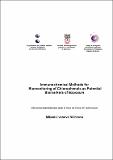Por favor, use este identificador para citar o enlazar a este item:
http://hdl.handle.net/10261/24105COMPARTIR / EXPORTAR:
 SHARE
BASE SHARE
BASE
|
|
| Visualizar otros formatos: MARC | Dublin Core | RDF | ORE | MODS | METS | DIDL | DATACITE | |

| Título: | Immunochemical methods for biomonitoring of chlorophenols as potential biomarkers of exposure |
Autor: | Nichkova, Mikaela | Director: | Marco, María Pilar CSIC ORCID CVN | Palabras clave: | Immunoquímica Triclorofenols (TCP) |
Fecha de publicación: | 2003 | Editor: | Universidad de Barcelona | Resumen: | The thesis presents the development of immunochemical methods for detection of trichlorophenols (TCP) in environmental and biological samples. An indirect enzyme linked immunosorbent assay (ELISA) for 2,4,5-TCP has been developed after a rational design of the immunizing hapten chemical structure, and the screening of 12 competitor haptens. The effect of the conjugation degree of the competitors and their homology with the target analyte, the physicochemical parameters (pH, ionic strength), the concentration of detergent, the time of incubation and the specificity were studied. Two immunoassays (2,4,5- and 2,4,6-TCP ELISAs) were evaluated for the analysis of water, milk, serum and urine. Drinking water was analyzed directly after buffering the sample. The strong matrix effects in milk samples requires the sample clean up. Human serum can be analyzed after protein precipitation with absolute ethanol. The strong matrix effect of urine and its variability for samples from different individuals suggested the introduction of a purification step prior to ELISA. The C18- solid phase extraction (SPE) is an effective clean up method to remove an important part of the nonspecific interferences present in urine. The C18-SPE-ELISA method allows accurate quantification of TCPs in urine of occupationally exposed persons. SPE based on immunosorbents (immunoaffinity extraction, IAE) have been developed in single and 96-column formats. IAE is an effective clean up method to remove all nonspecific urinary interferences. The IAE step was optimized regarding sample volume, loading level, type of urine hydrolysis washing and elution conditions. The selectivity of the immunosorbents can be modulated by the washing conditions. The immunosorbents have sufficient capacity to effectively extract 2,4,6-TCP from urine samples of occupationally exposed persons and the general population. The HTS-IAE-ELISA method allows the processing of 100 samples/day with very good precision and accuracy. The method was validated with GC-MS and applied to the biomonitoring of three groups of population from Catalonia. A quenching fluorescence immunoassay based on the laser-induced fluorescence detection in microdroplets (LIF-microdroplet-QFIA) for 2,4,6-TCP has been developed as a novel biodetection system. This approach offers significant improvement in method detectability compared to the microplate immunoassays and is the first application urine samples that can be directly analyzed after sample dilution. |
Descripción: | Tesis del Departament de Química Analítica de la Universitat de Barcelona (UB).-- Fecha de defensa 30-5-2003. | Versión del editor: | http://www.tdx.cat/TDX-0702103-112046 | URI: | http://hdl.handle.net/10261/24105 | ISBN: | 84-688-2819-X |
| Aparece en las colecciones: | (IQAC) Tesis |
Ficheros en este ítem:
| Fichero | Descripción | Tamaño | Formato | |
|---|---|---|---|---|
| Nichkova_Mikaela.pdf | 2,97 MB | Adobe PDF |  Visualizar/Abrir |
CORE Recommender
Page view(s)
325
checked on 18-abr-2024
Download(s)
862
checked on 18-abr-2024
Google ScholarTM
Check
Altmetric
NOTA: Los ítems de Digital.CSIC están protegidos por copyright, con todos los derechos reservados, a menos que se indique lo contrario.
